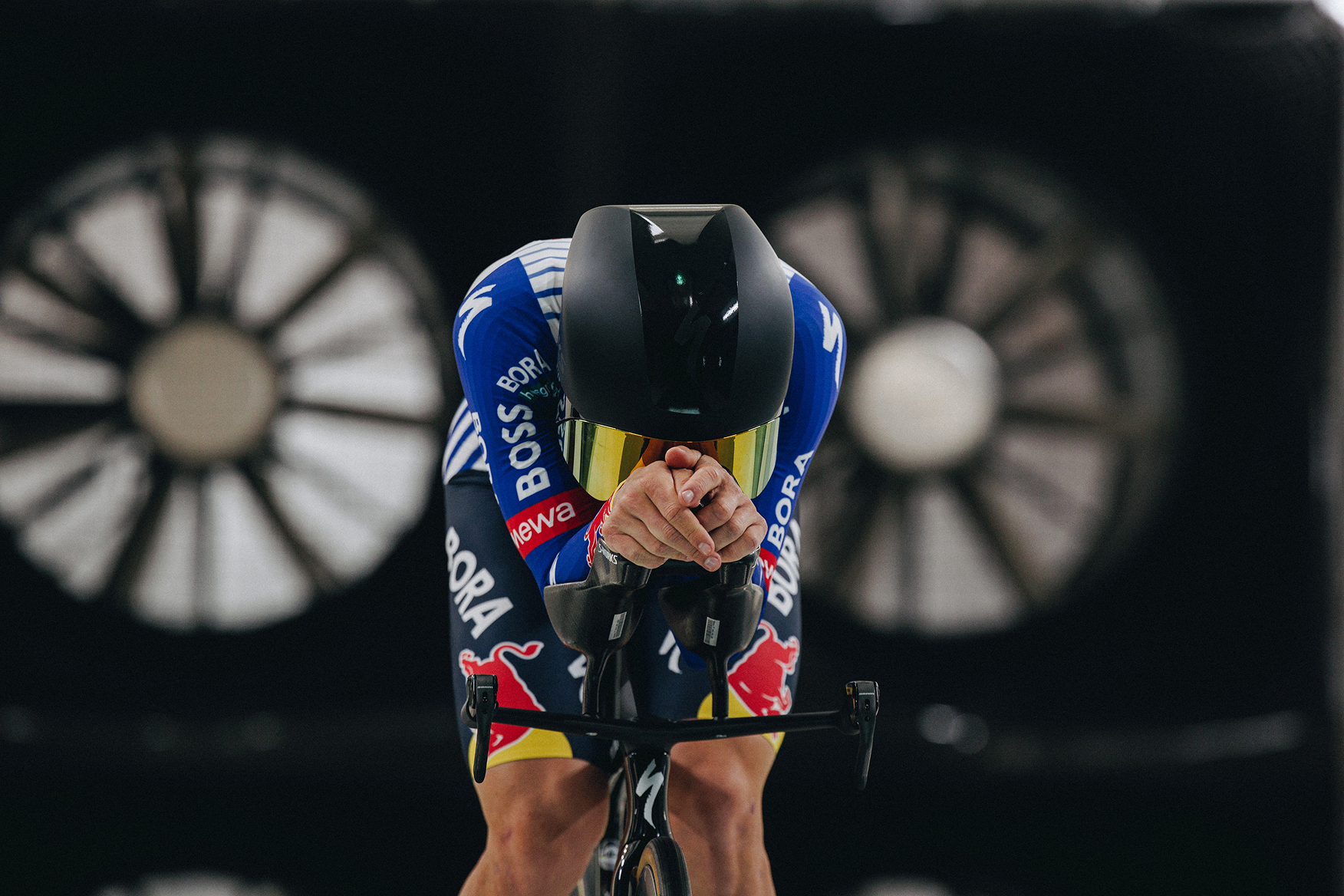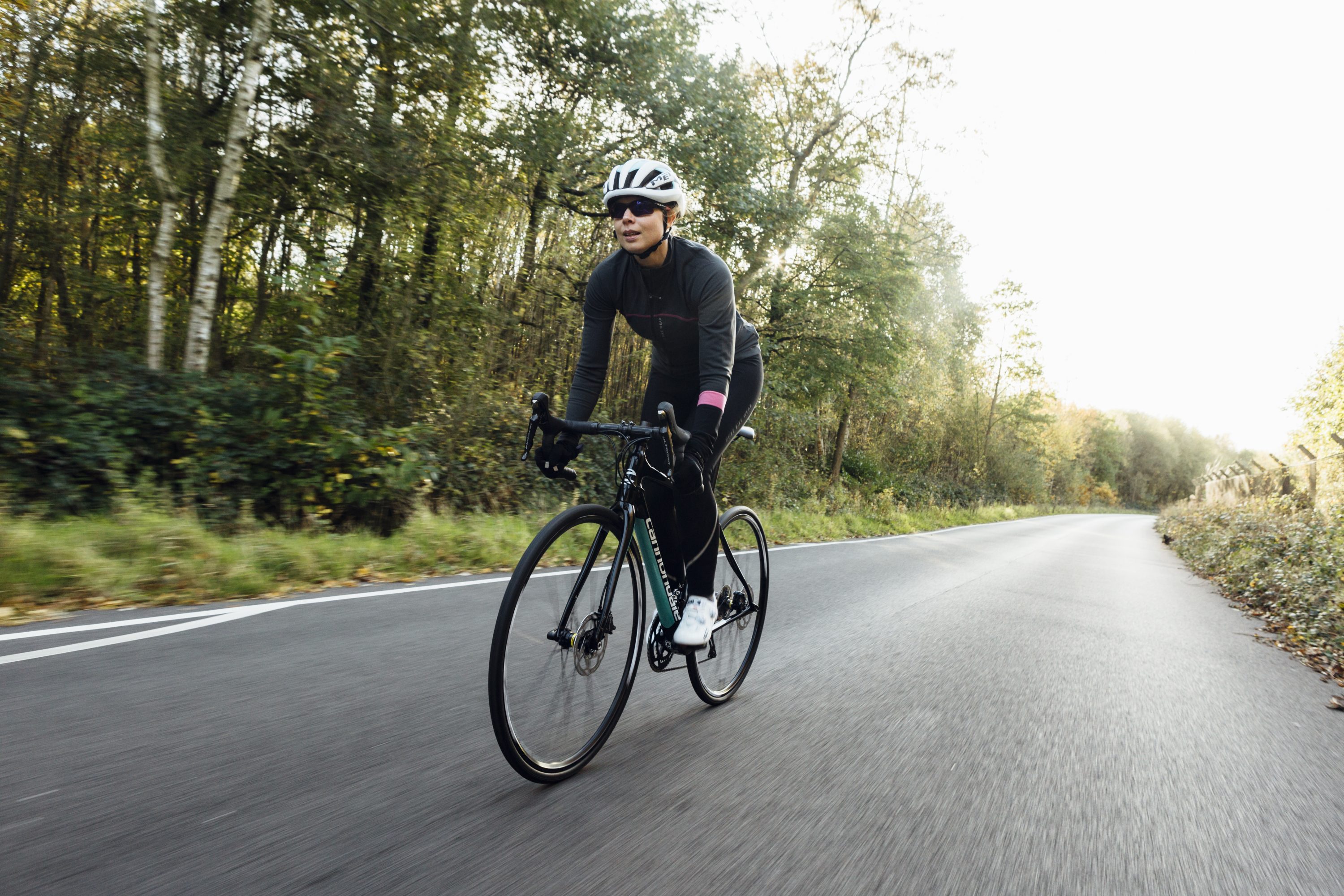Watch: how much faster is a time trial bike, really?
We headed to the wind tunnel to delve into the data

A promotional feature in association with Boardman , first published in 2019
‘Will a time trial bike really make me that much faster?’ – it’s a question I’ve been asked a lot of times. I’ve always answered in support of our heavier, tri-barred rigs: it’s massive. Minutes, easily, over a blue ribbon 25.
However, checking myself in at the (since closed) Boardman Performance Centre in Evesham, I finally had the chance to get into the windtunnel and collect the data behind my assumption – and some of it surprised me.
In short: the results...
| Bike/position | Watt saving vs baseline |
| AIR road bike, on hoods, at 40kph | Baseline |
| AIR road bike, on drops, at 40kph | 18 |
| AIR road bike, on drops, tucked, at 40kph | 38 |
| AIR road bike, tucked on tops, at 40kph | 39 |
| AIR road bike, clip on bars, position 1, at 40kph | 66 |
| AIR road bike, clip on bars, optimised*, at 40kph | 83 |
| TTE time trial bike, to travel 40kph, at 40kph | 86 |
| TTE time trial bike, narrower arms, at 40kph | 87 |
| TTE time trial bike, at 50kph | 21 vs AIR with clip ons |
Boardman’s Aerodynamicist Dr Jamie Pringle was there to test and advise me, first aboard Boardman’s AIR aero road bike, followed by the AIR road bike with clip on bars, then the wind cheating TTE time trial bike.
Testing the AIR aero road bike, at 40km/h with a 7.5-degree yaw angle, we began by assessing my coefficient of drag (CdA) and resultant watt saving in an assortment of positions: on the tops, on the drops, 'tucked' on the drops, and 'hunched' on the tops. The final position is often considered to be the optimum for mimicking time trial savings on a road bike, if you can ignore the bicep ache and sustain it.
For me – on the AIR in this set up, tucking into the drops proved fastest – at an impressive 38 watt saving vs sitting on the tops. This represents an increase of 2.13km/h, and a time saving of 3 minutes 03 seconds over a 40km event.
The 'hunch’ on the tops was remarkably not much faster, suggesting I’m best off abandoning my pursuit of this position. However it’s worth bearing in mind that further optimisation – narrower bars and a longer stem - could see an uplift here.
Next, we added a pair of clip on bars to the AIR road bike. You can purchase a pair of these for around £100. This cost effective hack proved to be remarkably successful, saving 66 watts - equating to a saving of 5min 20s vs the ‘tops’ road bike position, and 2min 17s when compared to the fastest ‘drops’ position.
However, when Pringle stepped in to optimise the position: narrowing and raising my hands, pushing the saddle forwards and instructing me to tuck my head into the famous “turtle” stance, the difference was greater: 83 watts.
This new position was a substantial 6mins 51s faster than the ‘tops’ road bike position, and 3min 48s faster than the ‘drops’ position. Granted, you'll need to move your hands to shift gear, an inconvenience saved on a time trial bike, but this is still a chunk carved off the time spent in the pain cave which is hard to ignore.
We can't ignore the fact that the AIR is not a 'standard road bike' - it has been designed to be tinkered with and taken very close to a TT ready rig, with a four-position seat post. This allowed for effectively a 76 degree seat position and a low front end on the X-Small road bike I was aboard, and a taller rider might not be equally rewarded on a larger bike.
In part, the position I was able to work myself into on the AIR may explain my surprise at the next result. Once we fitted me in an identical position on the TTE time trial bike, the CdA saving was 2.3 per cent, equating to only 4 watts – or 26s over 40km.
Both bikes have been windtunnel tested and optimised to push through the air as quickly as possible. But the TTE has additions: the integrated front end, tidied brake levers and the lack of hoods, to name a few.
With eyebrows raised at the limited improvement, we tested the same position at a higher speed: 50km/h, with a 2.5 degree yaw angle, the sort of pace the bike is arguably designed for.
At this speed, the saving afforded by the time trial bike shot up to 5.9 per cent – 21 watts faster than the AIR with clip on bars, equating to a 55s saving: a valuable near-minute for a competitive tester.

Commenting on the findings, Pringle explained: “Some readers might have expected a bigger margin between the AIR aero road bike and TTE time trial bike bike. However, we’re often seeing well-designed aero road bikes getting very close to their thoroughbred time trial bike counterparts.
“Indeed, the AIR and TTE share much of the same DNA, with similar tube profiles and finishing kit.”
The 50kph speed of the second test equates to a 50-minute 25 mile time trial. That’s six minutes faster than my best ever performance. However, Pringle points out that we don’t ride at an ‘average’ speed.
“Some riders may think these speeds are unrealistic and out of their league, but remember our on the open road the average speed of the race doesn’t tell the whole story and there will be times in the race when the 40 km/h rider exceeds 50 km/h and perhaps even nudges 60 km/h - downhills and so on.”
Finally – it’s worth remembering that we didn’t delve deeper to investigate the further savings available from helmet and skinsuit choice.
“There is, undoubtedly, gain to come from these areas, albeit no-where near the very big differences that position on the bike can make.
“We’ve taken the biggest leaps in performance in simply getting her onto TT bars, and further strides in optimising that and then the bike change.
“My suggestion is that with a further session or two, we could take Michelle’s CdA down to around 0.17 to 0.18 and probably lower, with a number of smaller steps. That would bring her closer to the best performers against the clock.”
With that, perhaps I’ll be dusting of my Cycling Time Trials account for some summer racing…
The latest race content, interviews, features, reviews and expert buying guides, direct to your inbox!
Michelle Arthurs-Brennan the Editor of Cycling Weekly website. An NCTJ qualified traditional journalist by trade, Michelle began her career working for local newspapers. She's worked within the cycling industry since 2012, and joined the Cycling Weekly team in 2017, having previously been Editor at Total Women's Cycling. Prior to welcoming her first daughter in 2022, Michelle raced on the road, track, and in time trials, and still rides as much as she can - albeit a fair proportion indoors, for now.
Michelle is on maternity leave from April 2025 until spring 2026.
-
 Specialized claims its new Red Bull & Remco-developed pro kit can save you 25 watts – here’s what that really means
Specialized claims its new Red Bull & Remco-developed pro kit can save you 25 watts – here’s what that really meansCould a jersey upgrade really save you as many watts as the best aero bikes? We dig into Specialized's latest clothing tech to find out
-
 Ben Healy says you can't say cycling is 100% clean – he's right, but should we be worried?
Ben Healy says you can't say cycling is 100% clean – he's right, but should we be worried?Suspicion and mistrust are cycling's cross to bear
-
 How quickly do you recover when you taper for a race?
How quickly do you recover when you taper for a race?The science of tapering can be a minefield, even for the most experienced cyclist.
-
 Watch: Should women be training differently to men?
Watch: Should women be training differently to men?In Partnership with The Sufferfest
-
 Women’s cycling on Zwift: week of activity celebrates International Women’s Day
Women’s cycling on Zwift: week of activity celebrates International Women’s DayZwift Women's Week will take place between March 8 and March 15
-
 Winter turbo training tips: maintain form through the winter
Winter turbo training tips: maintain form through the winterVO2 max sessions will ensure you’re both fresh and fit for spring
-
 Feel more comfortable, ride faster and prevent injuries with a physio led bike fit
Feel more comfortable, ride faster and prevent injuries with a physio led bike fitIf you are preparing for a sportive, then a visit to Six Physio will help you get in the best possible condition for your goal cycling event.

